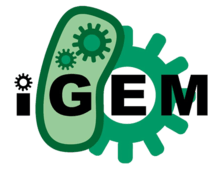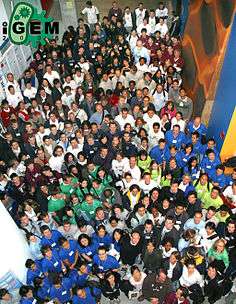International Genetically Engineered Machine
| International Genetically Engineered Machine | |
|---|---|
 | |
| Date(s) | October 27 –October 31, 2016 |
| Frequency | Annually |
| Location(s) |
Boston, Massachusetts, United States With additional events worldwide |
| Inaugurated | 2003 |
| Most recent | 2016 |
| Website | |
|
www | |

The International Genetically Engineered Machine (iGEM) competition is a worldwide synthetic biology competition that was initially aimed at undergraduate university students, but has since expanded to include divisions for high school students, entrepreneurs, and community laboratories, as well as 'overgraduates'.
Competition details
Student teams are given a kit of biological parts at the beginning of the summer from the Registry of Standard Biological Parts consisting of various genetic components such promoters, terminators, reporter elements, and plasmid backbones. Working at their own schools over the summer, they use these parts and new parts of their own design to build biological systems and operate them in living cells. Randy Rettberg, an engineer who has worked for technology companies including Apple, Sun and BBN,[1] is the director of the iGEM competition.
Biological systems / BioBricks
One of the aims of the competition is to attempt to build simple biological systems from standard, interchangeable parts and operate them in living cells.
The iGEM competition facilitates this by providing a library of standardized parts (called BioBrick standard biological parts) to students, and asking them to design and build genetic machines with them. Student teams can also submit their own BioBricks. Successful projects produce cells that exhibit new and unusual properties by engineering sets of multiple genes together with mechanisms to regulate their expression.
Information about BioBrick standard biological parts, and a toolkit to make and manipulate them, is provided by the Registry of Standard Biological Parts, or simply, the Registry. This is a core resource for the iGEM program, and one that has been evolving rapidly to meet the needs of the program.
Broader goals
Beyond just building biological systems, broader goals of iGEM include:
- To enable the systematic engineering of biology.
- To promote the open and transparent development of tools for engineering biology.
- And to help construct a society that can productively and safely[2] apply biological technology.
iGEM's dual aspects of self-organization and imaginative manipulation of genetic material have demonstrated a new way to arouse student interest in modern biology and to develop their independent learning skills.
Growth and recent years
iGEM developed out of student projects conducted during MIT's Independent Activities Periods in 2003 and 2004.[3][4] Later in 2004, a competition with five teams from various schools was held. In 2005, teams from outside the United States took part for the first time.[5] Since then iGEM has continued to grow, with 130 teams entering in 2010.[6]
Because of this increasing size, in the years 2011 - 2013 the competition was split into three regions: Europe, the Americas, and Asia (though teams from Africa and Australia also entered via "Europe" and "Asia" respectively).[7] Regional jamborees occurred during October; and some subset of teams attending those events were selected to advance to the World Championship at MIT in November.[8]
In January 2012 the iGEM Foundation was spun out of MIT as an independent non-profit organization located in Cambridge, Massachusetts, USA. The iGEM Foundation supports scientific research and education through operating the iGEM competition. The same year, iGEM expanded into having not only the Collegiate division, but also competitions for entrepreneurs and high school students.
For their tenth anniversary iGEM added new tracks to the existing ones: Art & Design, Community Labs, Entrepreneurship, Measurement, Microfluidics, Policy & Practice, and Software. Although Entrepreneurship and Software were tracks in previous years, in 2014 they were made more distinct in terms of their judging requirements.[9] Furthermore, in 2014 iGEM did not have regional jamborees, but instead hosted a giant jamboree so every team could participate in one conference in Cambridge unlike in previous years where only the regional finalists were brought to Cambridge.[10]
Competition results
High School Division
| Grand Prize | 2nd | 3rd | Complete Results | |||
|---|---|---|---|---|---|---|
| 2016 | HSiTAIWAN | iGEM 2016 | ||||
| 2015 | TAS Taipei | iGEM HS 2015 | ||||
| 2014 | CSIA-SouthKorea | TP CC-SanDiego[note 1] | TAS Taipei | iGEM HS 2014 | ||
| 2013 | Lethbridge Canada | AUC Turkey | CIDEB-UANL Mexico | iGEM HS 2013 | ||
| 2012 | Heidelberg LSL | NC School of Sci Math | CIDEB-UANL Mexico | iGEM HS 2012 | ||
| 2011 | Years prior to 2012 had no separate high school division | |||||
Undergraduate Division
| Grand Prize | 2nd | 3rd | Nominated | Nominated | Nominated | Complete Results | |
|---|---|---|---|---|---|---|---|
| 2016 | Imperial | Sydney Australia | SCAU-China | Peking | UC Davis | iGEM 2016 | |
| Grand Prize | 2nd | 3rd | 4th | 5th | 6th | Complete Results | |
| 2015 | William and Mary | Czech Republic | Heidelberg | iGEM 2015 | |||
| 2014 | Heidelberg | Imperial | NCTU Formosa | iGEM 2014 | |||
| 2013 | Heidelberg | TU Munich | Imperial | iGEM 2013[note 2] | |||
| 2012 | Groningen | Ljubljana | Paris Bettencourt[note 3] | LMU Munich | iGEM 2012 | ||
| 2011 | Washington | Imperial | ZJU China | MIT | iGEM 2011 [note 4] | ||
| 2010 | Ljubljana | Peking | BCCS Bristol | Cambridge | Imperial | TU Delft | iGEM 2010 |
| 2009 | Cambridge | Heidelberg | Valencia | Freiburg | Groningen | Imperial | iGEM 2009 |
| 2008 | Ljubljana | Freiburg | Caltech | Harvard | NYMU Taipei | UC Berkeley | iGEM 2008 |
| 2007 | Peking | Paris | Ljubljana | UC Berkeley | UCSF | USTC | iGEM 2007 [note 5] |
| 2006 | Ljubljana | Imperial | Princeton | iGEM 2006 | |||
| 2005 | Years prior to 2006 had no specific winners | iGEM 2005 | |||||
| 2004 | IAP 2004, SBC 2004 | ||||||
| 2003 | IAP 2003 | ||||||
Overgraduate Division
| Grand Prize | 2nd | 3rd | Nominated | Nominated | Nominated | Complete Results | |
|---|---|---|---|---|---|---|---|
| 2016 | LMU & TU Munich[note 6] | Wageningen UR | TU Delft | Pasteur Paris | Slovenia[note 7] | iGEM 2016 | |
| 2015 | TU Delft | BGU Israel | Years prior to 2016 had no finalists nominations. | iGEM 2015 | |||
| 2014 | UC Davis | Wageningen | TU Darmstadt | iGEM 2014 | |||
| 2013 | Paris Bettencourt | Bielefeld | Sun Yat-sen | iGEM 2013[note 8] | |||
Notes
- ↑ Combined team from Torrey Pines High School and Canyon Crest Academy.
- ↑ In 2013 iGEM was divided into an undergraduate and an overgraduate section. The criterium for division was the participance of team members older than 23 years.
- ↑ Students were from different universities of Paris (Paris Descartes University, Paris Diderot University, Pierre and Marie Curie University).
- ↑ As of June 2012, the 2011 results page does not include results from the Championship Jamboree; but details can be found at the Jamboree page.
- ↑ 2007 had six finalists but none were selected as specific runners-up.
- ↑ Combined team from Technische Universität München and Ludwig-Maximilians-Universität München.
- ↑ In former years the team "Slovenia" was listed as "Ljubljana".
- ↑ In 2013 iGEM was divided into an undergraduate and an overgraduate section. The criterium for division was the participance of team members older than 23 years.
References
- ↑ "The Bleeding Edge" (PDF). IEEE. Retrieved 2010-03-17.
- ↑ Guan; et al. "Biosafety Considerations of Synthetic Biology in the International Genetically Engineered Machine (iGEM) Competition".
- ↑ "Learn about iGEM". Retrieved 2013-05-06.
- ↑ Trafton, Anne. "Rewiring Cells". Technology Review.
- ↑ "iGEM 2005". Retrieved 2013-05-06.
- ↑ "Previous iGEM Competitions". iGEM. Retrieved 2011-11-12.
- ↑ "Team List 2011". iGEM. Retrieved 18 October 2014.
- ↑ "Jamborees". iGEM. Retrieved 18 October 2014.
- ↑ "Tracks 2014". iGEM. Retrieved 24 October 2014.
- ↑ "Giant Jamboree". iGEM. Retrieved 24 October 2014.
Further reading
- Mooallem, Jon (2010-02-14). "Do-It-Yourself Genetic Engineering". New York Times. Retrieved 2010-05-04.
- "A Life of Its Own: Where will synthetic biology lead us?". New Yorker. 2009-09-28. Retrieved 2010-05-04.
- "iGEM Team Funding". Wellcome Trust. Archived from the original on December 2, 2010. Retrieved 2010-12-03.
- "Biosafety Considerations of Synthetic Biology in the International Genetically Engineered Machine (iGEM) Competition". Bioscience. 2013-01-13. Retrieved 2013-01-16.